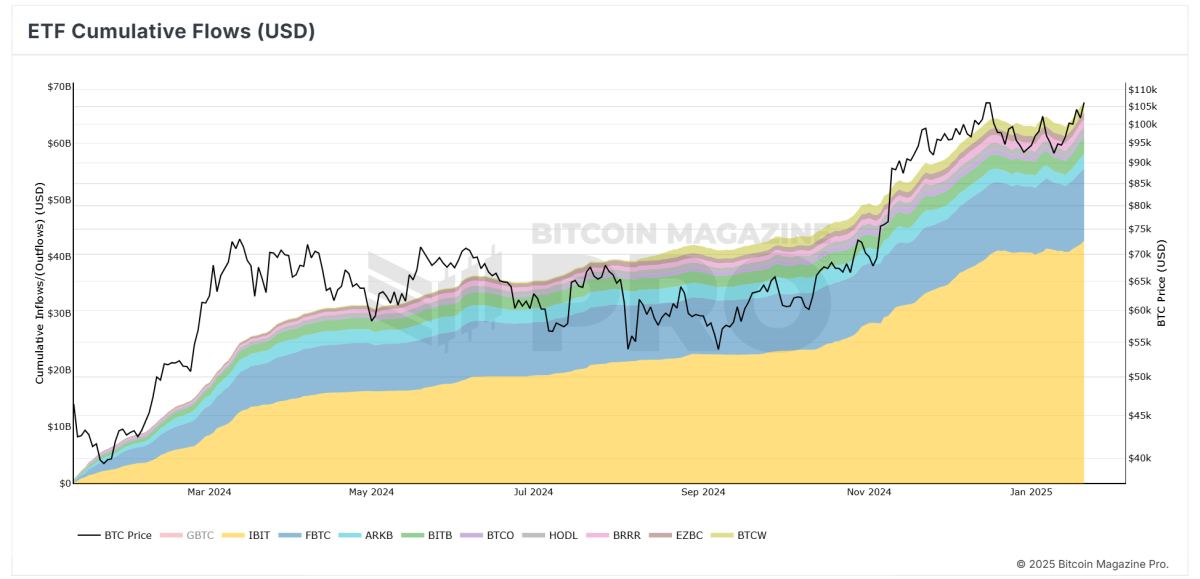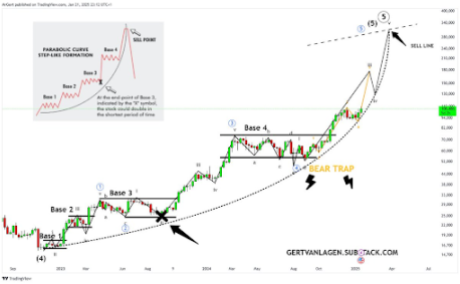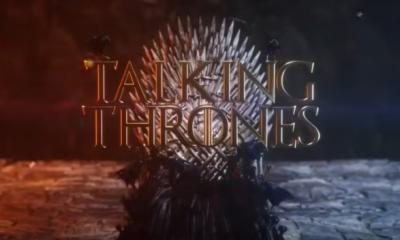CryptoCurrency
BlackRock CEO Larry Fink Forecasts $700K Bitcoin Price Amid Inflation Worries

Larry Fink, CEO of BlackRock, recently speculated that Bitcoin could potentially reach valuations as high as $700,000 per BTC. This projection arises against the backdrop of intensifying concerns about currency debasement and global economic instability, positioning Bitcoin as a hedge against vulnerabilities in traditional financial systems. Fink’s remark was not an outright endorsement but rather a reflection on a recent meeting he had with a sovereign wealth fund. The fund sought advice on whether to allocate 2% or 5% of its investment portfolio to Bitcoin. According to Fink, if institutional adoption continues to grow and similar allocation strategies are embraced broadly, market dynamics could drive Bitcoin to such remarkable heights.
Fink made this striking statement during a recent interview, explaining that Bitcoin’s potential for exponential growth is closely tied to fears of economic downturns and fiat currency devaluation. Fink described Bitcoin as an “international instrument” capable of mitigating localized economic fears.
JUST IN: $11.5 trillion BlackRock CEO Larry Fink says Bitcoin could go up to $700,000 if there is more fear of currency debasement and economic instability.pic.twitter.com/WOXclAsjDP
— Bitcoin Magazine (@BitcoinMagazine) January 22, 2025
A Message to the Market
With BlackRock managing $11.5 trillion in assets, Fink’s words carry significant weight, sending a clear message to retail and institutional investors alike. His endorsement transcends personal opinion, serving as a market signal about Bitcoin’s potential trajectory. Long heralded as “digital gold,” Bitcoin is seen as a store of value that can protect wealth from inflation and governmental fiscal mismanagement. Fink’s recognition of this narrative could further accelerate its adoption among traditional investors.
Related: From Laser Eyes to Upside-Down Pics: The New Bitcoin Campaign to Flip Gold
A Timely Forecast
Fink’s prediction comes as global economies grapple with soaring inflation, escalating national debts, and geopolitical tensions that threaten currency stability. Bitcoin, with its fixed supply of 21 million coins and decentralized structure, presents an alternative asset class that is immune to the inflationary pressures inherent in fiat currencies. In this climate, its value proposition becomes increasingly compelling.
BLACKROCK IS BACK.
THEY JUST BOUGHT $600 MILLION OF BITCOIN, THEIR LARGEST BUY SO FAR THIS YEAR. pic.twitter.com/QLAm5eaik4
— Arkham (@arkham) January 22, 2025
BlackRock’s Bitcoin ETF: A Signal of Institutional Interest
BlackRock’s deepening involvement in Bitcoin reached a milestone on January 21, 2025, when the firm purchased $662 million worth of Bitcoin for its exchange-traded fund (ETF), their largest daily purchase so far this year.
BlackRock’s iShares Bitcoin Trust (IBIT) surpassed the firm’s iShares Gold Trust (IAU) in net assets in October 2024. This milestone was achieved just months after IBIT’s launch in January 2024, highlighting the rapid growth and increasing investor interest in Bitcoin-focused exchange-traded funds.

A Balanced Perspective
While Fink’s projection is undeniably bullish, it remains contingent on the continuation of current economic trends. If global economic stability improves or innovative financial systems emerge to alleviate fears of currency debasement, Bitcoin’s price trajectory may stabilize at a lower level. Nevertheless, Fink’s high-profile commentary underscores its growing role as a legitimate asset class.
Related: David Bailey Forecasts $1M Bitcoin Price During Trump Presidency
Bitcoin’s Next Chapter
Bitcoin’s evolution from a niche digital experiment to a mainstream financial instrument is accelerating. Fink’s remarks may signal a pivotal moment, not just for Bitcoin, but for its broader acceptance in traditional finance. For investors and enthusiasts, this is more than a vote of confidence—it’s a sign that the integration of Bitcoin into the global financial landscape is not only imminent but already underway.
As the world watches, Bitcoin’s role in redefining finance continues to grow. Fink’s prediction serves as a reminder that Bitcoin is no longer a fringe idea but a crucial player in the future of money.
CryptoCurrency
What Can Crypto Traders Learn from Traditional Forex Platforms?

When the concept of cryptocurrency was introduced back in 2009 – when the first Bitcoin whitepaper was released by the anonymous creator, Satoshi Nakamoto – its unique selling point was that it was different. By that we mean, the idea of a decentralised, peer-to-peer digital currency that could operate independently was revolutionary for the financial market.
Trading crypto, too, was a different experience compared to trading on traditional Forex platforms. Unlike Forex markets, which are heavily regulated and rely on central authorities like banks or brokers, cryptocurrency transactions are recorded on blockchain, a distributed ledger that is transparent and independent of any governing body, introducing a whole new dynamic for traders.
While this is still true today, however, as the cryptocurrency market has evolved, significant similarities between both markets have come to light. In 2025, crypto traders can learn a lot from traditional Forex platforms, with both markets having merged in terms of accessibility, tools, and strategies. Whether it’s through Forex trading apps or crypto trading platforms, traders now have access to similar features that enable them to execute trades efficiently and strategically, and if you look closely, the way in which they do so is not so different.
Learning to Manage Risk
Everyone knows that the cryptocurrency market is volatile. One day, the price of Bitcoincould be reaching a high of $106,000, the next it could have dropped down to $95,000. As a result, entering the crypto market is a risk in itself, but there are ways to mitigate that risk and ensure it never becomes too damaging.
Forex traders have long used risk management strategies to protect their capital, with stop-loss orders, take-profit orders, and position sizing being common risk management tools that can be found on Forex platforms. By setting a stop-loss at a predetermined price, traders can limit potential losses if the market moves against them. Similarly, setting take-profit orders allows traders to lock in profits when the market reaches a specific level.
These are standard practices in the traditional Forex market, and they can be beneficial practices in the crypto market too. For investors buying BTC, ETH, or any other altcoin, adopting risk management strategies can work to mitigate the high volatility and unpredictable nature of what is a very unpredictable market.
Learning to Trade Responsibly
Another thing that crypto traders can learn from traditional Forex platforms is the ability to trade responsibly. In Forex trading, emotional control and maintaining discipline are critical factors for long-term success. Provided an investor utilises a trusted, regulated platform, they should not only be receiving access to the financial market, but information and guidance on how to safely navigate that access.
To give an example, on the Exness app – one of the up-and-coming platforms for both Forex and crypto traders alike – investors can access a wide range of educational resources, including guidelines on trading psychology, discipline, and emotional control. For those asking: “is Exness legit?”, this is one of the key signifiers that a platform is committed to helping traders succeed, and it’s also must-have information in both a Forex and crypto context.
As an investor, it can be very easy to let emotions get the better of you. The fast-paced nature of both Forex and crypto markets often triggers impulsive decisions based on a range of factors, and this emotional response can easily lead to overtrading, chasing losses, or taking unnecessary risks that ultimately erode profits. Through digesting the tips and guidelines of platforms like Exness, however, it’s possible to learn how to mitigate these symptoms and make informed, strategic decisions based on fact rather than emotion.
Learning to Manage
Whether you’re a new investor in crypto or Forex – or both – you’ll learn very quickly that you are your own manager. You can follow all the necessary guidelines and steps, but ultimately, you are in charge of your portfolio, and it’s up to you to manage it effectively. One of the reasons Forex trading has become more accessible in recent years, however, is because the platforms are specifically designed to support this level of personal responsibility, offering tools and features that enable traders to take full control of their investments.
As mentioned before, this includes risk management tools, but also real time access to market data. On a Forex platform, you can track live price movements, monitor currency pair fluctuations, and follow global economic events that are bound to affect market behaviour. You can also utilise automated trading options, such as bots or algorithms that program the platform to execute trades for you based on specific criteria – helping you stick to your plan without getting swayed by emotional impulses.
In terms of the crypto market, it is these kinds of tools that you can learn from and utilise when managing your crypto portfolio. In both markets, of course, diversification is crucial in mitigating risk, but especially in the crypto-verse, this makes it harder to keep control in a volatile space and remain aware of everything going on. To succeed, it is crucial to take advantage of platforms offering this level of help, working to keep you on top of your game and flourishing, no matter where the market swings.
Disclaimer: This article is provided for informational purposes only. It is not offered or intended to be used as legal, tax, investment, financial, or other advice.
CryptoCurrency
Bitcoin price probably ‘chops’ in $100K–$110K range until FOMC meeting

Analysts believe US interest rates will not change, but Bitcoin price could benefit if the Federal Reserve mentions quantitative easing at the next FOMC.
CryptoCurrency
Cardano and XRP investors get in early on new wallet technology


Disclosure: This article does not represent investment advice. The content and materials featured on this page are for educational purposes only.
Cardano (ADA) and XRP investors are buzzing about 1Fuel’s wallet technology, looking to get in early.
Cardano (ADA) and Ripple (XRP) are widely known for their blockchain solutions, and achieved more fame when they announced plans to collaborate. But lately, their investors have been more interested in 1Fuel (OFT), especially since its new wallet technology might transform the DeFi landscape.
This DeFi wallet is important to 1Fuel’s ecosystem, offering cross-chain transaction capability and privacy tools. With the 1Fuel presale quickly progressing, there has been a lot of excitement surrounding the public listing.
Cardano and Ripple plan collaborative projects
Recently, the founder of Cardano, Charles Hoskinson, and the CEO of Ripple, Brad Garlinghouse, announced that they have been discussing collaborations. Once this news broke out, the value of the two altcoins increased in a week. Cardano‘s price increased by 1.14% while XRP rose by 20.68%, further attracting investor interest.
This potential collaboration has caused investors to rank ADA and XRP among the best altcoins. With their rising in value, these tokens can be easily managed on wallets like MetaMask and Trust Wallet.
New wallet technology piques widespread interest
1Fuel has emerged with a new wallet technology which is attracting a lot of attention, especially from ADA and XRP whales. This technology is expected to transform the DeFi space, driving 1Fuel’s value as one of the best altcoins.
One of the best parts of this wallet is cross-chain transactions and one-click technology. This is a major advantage over platforms like MetaMask and Trust Wallet, which require multiple wallets and tokens for cross-chain swaps. With only the 1Fuel token, investors can freely send altcoins from one blockchain to another.
1Fuel is also fitted with highly advanced financial tools that make it easy to manage digital assets. These include crypto debit and credit cards, peer-to-peer (P2P) exchange, disposable wallets, and AI-driven features. With all of these, 1Fuel could be a top DEX wallet, especially as it features an inbuilt privacy mixer and cold storage. These are privacy features that are usually lacking in well-known platforms like MetaMask and Trust Wallet.
1Fuel presale sees fast progress
The 1Fuel presale has been moving at an impressive pace, which is a sign of the widespread investor interest and confidence. In just a week, stage 1 achieved 100% completion while stage 2 had a similar progress. Now it is in stage 3 and over 30% complete, selling over 146 million tokens and raising $1.4 million.
Investors can buy the token at $0.017 in stage 3. Analysts predict that 1Fuel could rise by 100x in 2025, and investors are highly anticipating long-term growth.
1Fuel’s launch
Investors are looking forward to 1Fuel’s public listing in Q2 2025. Supported by a robust DeFi ecosystem, 1Fuel could change how digital assets are managed. The exchange technology is offering an edge over widely known blockchain systems like Cardano and Ripple.
To find out more about 1Fuel, visit their website, Telegram, or X.
Disclosure: This content is provided by a third party. crypto.news does not endorse any product mentioned on this page. Users must do their own research before taking any actions related to the company.
CryptoCurrency
2025 Will Be a Year of Self-Custody


An industry-wide debate over crypto institutional adoption and centralized custody risk will trigger a surge of interest in self-custody, OKX’s President Hong Fang said in a recent interview with CoinDesk.
While institutional adoption and the increasing popularity of crypto ETFs are a net positive for the industry, there may be a shift in industry narrative to caution against custody concentration risk, Fang argued. She predicts that most native crypto users will adopt self-custody this year.
On OKX, assets held in its self-custody wallets (almost $50 billion) exceed assets on its centralized exchange ($30.8 billion).
This series is brought to you by Consensus Hong Kong. Come and experience the most influential event in Web3 and Digital Assets, Feb.18-20. Register today and save 15% with the code CoinDesk15.
“The tension between adoption and concentration risk will come under a spotlight,” said Fang, who will be a speaker at Consensus Hong Kong in February. “Against this backdrop, I anticipate more industry campaigns to educate why self-custody is important and how to use it, and more products to make it easier for the masses to use self-custody and alleviate the risks accordingly.”
According to Fang, OKX DEX volume has increased 20 times. But she argues that DEXs and centralized exchanges are complementary.
“The crypto-native audience will want to be able to use CEX for reliability and DEX for catching innovations,” she said. “Such supply-demand dynamics will drive further adoption of DEX to enable innovation while supporting the gradual maturity of the crypto regulatory framework.”
A bitcoin strategic reserve?
A national bitcoin strategic reserve, a policy touted by the new Trump administration, would serve to centralize the leading cryptocurrency. But many in crypto doubt it will actually happen, if bettors on Polymarket are any guide (as of Jan. 22, they were putting the chances of Trump creating such a reserve in the first 100 days of his administration at just 30 percent.)
Fang agrees with this sentiment.
“I personally find it hard to believe that major sovereign countries like the U.S. will officially adopt bitcoin strategic reserve at the federal level at this stage, but it is very possible that smaller sovereign countries or states could,” she said.
But, this being crypto, anything is possible.
Very unexpected events — like a lack of follow through by the Trump administration on its crypto promises — could dampen the bull run quickly, she said. But the biggest risk according to Fang remains over-centralization.
For that risk there’s a vaccine: self-custody. Which, according to OKX, the market is quickly adopting.
CryptoCurrency
Ripple (XRP) Price Will Hit $5 In Q1 Of 2025 If This One Thing Happens. What Is The Latest Remittix News


Ripple’s most recent surge saw its price surge past $3.38, causing speculation as to whether Ripple could surpass the critical $5 mark in Q1 of 2025. Meanwhile, a new contender, Remittix (RTX), has been gaining traction for its advanced PayFi solution. It promises to address the longstanding frustrations of individuals and businesses who need to make global payments on a regular basis, often facing high costs, hidden charges, and lengthy delays. Currently powering through its presale, Remittix is seeing major investment, having raised over $3.85 million in just a few weeks. So what could Remittix achieve in 2025, and will Ripple (XRP) be able to reach $5?
Ripple’s Momentum Stalls At $3.15
Ripple (XRP) has been on a real journey this last week. Between 14th and 16th January it shot up from $2.54 to $3.38 in a short window before plummeting to $3.04. It is now back to $3.15 where it seems to be settling. This price point seems to have stagnated for the short term, but where it might head next is unclear. The market cap for Ripple is now sitting at around $180 billion and its 24 hour trading volume dropped by 8% in the last day. Optimistic holders think the new administration will boost Ripple’s price if Trump’s team shows signs of loosening crypto regulations.
Remittix Ushers in a New Era for Global Payments
Focusing on resolving inefficiencies in the cross-border payments market, Remittix (RTX)taps into the $190 trillion industry with precision. Facilitating the conversion of over 40 cryptocurrencies into fiat, the platform allows users to send funds directly to bank accounts worldwide.
For businesses, the Remittix Pay API is a standout feature, simplifying the integration of crypto payments into existing systems while offering easy and accessible fiat settlement options. Additionally, merchant accounts are tailored for companies managing multiple currencies, supporting over 50 crypto pairs and 30 fiat currencies. This flexibility makes Remittix (RTX) an adaptable solution for diverse financial needs.
Helping bridge the gap in regions with limited access to traditional financial services, Remittix supports individuals and businesses by providing 24/7 access to global payment systems. With low fees and efficient processing times, it is particularly attractive to users in underserved areas, breaking down barriers to participating in the international economy.
Remittix Soars In Presale, Surpassing $4 Million
Central to the Remittix (RTX) ecosystem is the RTX token, intelligently designed for growth with applications in staking, governance, and platform rewards. With a capped supply of 1.5 billion tokens, RTX is rapidly gaining traction among forward-thinking investors.
Currently, priced at $0.0239 in its presale phase, the RTX token has already exceeded $4.6 million raised! Thanks to its compelling value proposition in the lucrative cross-border payments market, analysts project an 800% gain during the presale, with further growth expected as adoption grows. For investors seeking the next major opportunity in PayFi, this is a chance not to be missed.
Discover the future of PayFi with Remittix by checking out their presale here:
Website: https://remittix.io/
Socials: https://linktr.ee/remittix
Disclaimer: This is a sponsored press release and is for informational purposes only. It does not reflect the views of Crypto Daily, nor is it intended to be used as legal, tax, investment, or financial advice.
CryptoCurrency
Coinbase files to dismiss BiT Global lawsuit over wBTC

The complaint, filed in December 2024, alleged “antitrust injury” from Coinbase over its decision to delist wrapped Bitcoin in favor of promoting its cbBTC product.
CryptoCurrency
XYZVerse and these 4 altcoins could make millionaires

Disclosure: This article does not represent investment advice. The content and materials featured on this page are for educational purposes only.
XYZVerse and these 4 altcoins could redefine crypto success stories, potentially creating the next wave of millionaires.
Early investors in cryptocurrencies like Ethereum reaped enormous rewards. Now, new digital assets are emerging with the potential for significant growth. This article explores XYZVerse, along with four other promising altcoins that offer a chance to catch the next wave of crypto success, potentially making millionaires.
XYZVerse secures $5.5 million in presale
XYZVerse is transforming the crypto space by fusing the excitement of sports with the charm of meme coins. Tailored for fans of football, basketball, MMA, and esports, this project seeks to bridge the gap between sports enthusiasts and crypto investors in search of the next big opportunity.
While many meme coins falter, XYZVerse sets itself apart with a robust roadmap and a commitment to long-term growth. Already in its presale phase, XYZVerse has attracted significant attention, raising over $5.5 million. This impressive milestone showcases the strong support and enthusiasm of its growing community.
The presale consists of 15 stages, with token prices incrementally rising at each phase. Currently priced at $0.002 in stage 10, XYZ is set to reach $0.1 by the presale’s conclusion, signaling substantial growth potential for early adopters.

XYZVerse aims to become the G.O.A.T. of meme coins, already earning accolades such as the best new meme project.
XYZVerse isn’t just about hype; it’s built on a solid tokenomics foundation designed for sustainability. With 15% allocated for liquidity and 10% reserved for community rewards, including bonuses and airdrops, the project is focused on fostering value. A deflationary burn mechanism will eliminate 17.13% of the total token supply over time, increasing scarcity and potentially boosting token prices.
Security and credibility are at the forefront of XYZVerse’s mission. The team has implemented smart contracts audits and has planned listings on both centralized and decentralized exchanges (CEX and DEX). These measures, combined with a fully vetted team, position XYZVerse as a credible project with a clear roadmap for growth.
Interested investors can be part of XYZVerse’s winning team via presale.
NEAR Protocol
NEAR Protocol’s price has seen modest downshifts recently. Over the past week, NEAR’s price declined by 2.56%. In the last month, the price changed by -5.95%.
Currently, NEAR is trading between $4.75 and $5.83. The 10-day simple moving average is $4.98, slightly below the 100-day average of $5.33. The Relative Strength Index (RSI) stands at 45.25, which suggests that the asset is neither overbought nor oversold. The Stochastic indicator is at 39.92, supporting the RSI’s neutral stance. The MACD level is -0.0677, hinting at slight bearish momentum.
Looking ahead, NEAR faces its nearest resistance at $6.55. Breaking above this level could pave the way toward the second resistance at $8.00. Moving to the first resistance would represent an increase of over 13%.
On the downside, the nearest support is at $3.63, and falling to this level would mean a decline of around 16%. If the price drops further, the second support at $2.18 comes into play. The data suggests that NEAR’s price could either bounce back from current levels or test these support zones in the near future.
Artificial Superintelligence Alliance
Over the past week, the FET token of the Artificial Superintelligence Alliance has declined by 5.29%. In the last month, it fell by 6.58%, and over the past six months, it has decreased by 3.46%. These consistent declines suggest a bearish trend in the market.
FET is currently trading between $1.13 and $1.43. The nearest support level is at $0.96, and a second support is at $0.66. If the price continues to decrease, it may test these support levels. On the upside, the nearest resistance level is at $1.55, with a second resistance at $1.84. Overcoming these resistances could indicate a shift towards a bullish trend.
The Relative Strength Index (RSI) is at 45.40, which is below the neutral 50 mark, suggesting slight bearish sentiment. The Stochastic oscillator is at 46.51, also indicating a neutral to bearish stance. The MACD level is negative at -0.0171, pointing towards bearish momentum. The 10-day Simple Moving Average is $1.16, which is below the 100-day SMA of $1.28, indicating that the short-term price is underperforming compared to the longer-term average.
Ondo
Ondo has shown significant movements. Over the past six months, its price increased by 37.68%. In the last month, however, it declined by 21.51%. This past week saw a recovery with a 2.65% rise. The coin is currently trading between $1.20 and $1.55.
Technical indicators present mixed signals. The Relative Strength Index (RSI) stands at 47.03, suggesting a neutral market. The MACD level is slightly negative at -0.0172, indicating mild bearish momentum. Meanwhile, the Stochastic at 62.63 points toward potential upward movement. The 10-day and 100-day simple moving averages are close at $1.29 and $1.33, indicating consolidation. Based on this data, ONDO’s price might stabilize or see moderate growth in the near term.
Looking ahead, the nearest resistance level is $1.80. If ONDO breaks through this, it could reach the next resistance at $2.26, representing an increase of about 43% from current levels. On the downside, support exists at $0.88 and further at $0.42 if the price dips significantly.
Hedera
Hedera has been performing strongly in recent times. In the past week, its price increased by 4.12%. Over the last month, it rose by 10.15%. Remarkably, in the past six months, HBAR has surged by 207.56%. This significant growth indicates rising interest in the coin.
Currently, HBAR trades between $0.32 and $0.40. It is approaching the nearest resistance level at $0.47. If it breaks through this point, the next target could be the second resistance at $0.62. Reaching this level would represent a substantial increase from the current price. On the downside, the nearest support level is at $0.18, which may provide a safety net if the price dips.
The Relative Strength Index is at 44.99, suggesting HBAR is neither overbought nor oversold. The 10-day Simple Moving Average is at $0.33, slightly below the 100-day average of $0.35. The MACD level sits at -0.0048, indicating slight bearish momentum. However, considering the recent price gains, there’s potential for the upward trend to continue. Traders will be watching these levels closely to see if HBAR can sustain its momentum.
Conclusion
While NEAR, FET, ONDO, and HBAR show promise, XYZVerse uniquely combines sports and meme culture, aiming for 20,000% growth and becoming the G.O.A.T of memecoins.
To find more information about XYZVerse, visit their website, Telegram, or X.
Disclosure: This content is provided by a third party. crypto.news does not endorse any product mentioned on this page. Users must do their own research before taking any actions related to the company.
CryptoCurrency
Bitcoin Price Aims For $150,000-$170,000 With Wave Formation, Here Are The Details

The Bitcoin price has shown a bullish pattern that could cause it to rally to between $150,000 and $170,000. Crypto analyst Gert van Lagen revealed how this could happen and what could come next after this price surge.
Bitcoin Price To Rally To As High As $170,000 Following Wave Formation
The Bitcoin price is set to rally to as high as $170,000 following a wave formation. In an X post, Gert van Lagen revealed that Bitcoin had confirmed blow-off wave 5 within the $150,000 and $180,000 range by recently reaching a new all-time high (ATH) of $109,000. Following this development, the analyst stated that the flagship crypto is now aiming to reach between $150,000 and $170,000.
Related Reading
Once the Bitcoin price rallies to between $150,000 and $170,000, Gert Van Lagen predicts that a retracement to as low as $120,000 will follow, with claims of a top. However, the rally to $170,000 won’t mark the cycle top for the flagship crypto as the analyst there will be another parabolic rally to the upside, which will be the wave v to complete the fifth wave.

Gert van Lagen predicts that the Bitcoin price will rally to as high as $300,000 on the last leg of this cycle, which would end the bull market. His accompanying chart showed that BTC could reach this price target by April. This isn’t the first time the analyst has predicted that the flagship crypto could rally to as high as $300,000. He previously highlighted a cup and handle pattern, which put the final ascent for BTC at this price target.
BTC Rally To $158,000 Still In Play
Crypto analyst Titan of Crypto also provided a bullish outlook for the Bitcoin price, stating that the projected rally to the $158,000 target is still in play. This target came about when he highlighted a bullish pennant forming on BTC’s monthly timeframe. The analyst remarked that Bitcoin could catapult to the moon if this bullish pattern plays out.
Related Reading
Meanwhile, in another X post, Titan of Crypto mentioned that the flagship crypto is back to its bullish momentum as it looks “extremely bullish” on the daily chart. This was based on his Ichimoku Cloud analysis, in which he pointed out that the cloud was turning bullish.
Amid these bullish outlooks for the Bitcoin price, crypto analyst Justin Bennett has warned that the flagship crypto could drop to as low as $91,000. He remarked that Bitcoin pumped into Trump’s inauguration, so there is a good chance that the rally fades from here. The analyst added that BTC is range-bound until proven otherwise and that the January 13th lower wick at $91,000 looks primed for a retest.
At the time of writing, the Bitcoin price is trading at around $105,402, up over 3% in the last 24 hours, according to data from CoinMarketCap.
Featured image from Unsplash, chart from Tradingview.com
CryptoCurrency
Trump’s CFTC Pick Clears Top Ranks of Key US Crypto Regulator


U.S. Commodity Futures Trading Commission Chairman Caroline Pham, the Republican commissioner who just took over the agency as President Donald Trump returned to the White House, ushered out many of the agency’s top officials under predecessor Rostin Behnam, the Democrat who’d been appointed by Joe Biden.
The staff changes — with each departure replaced by interim officials appointed by Pham — will have implications on cryptocurrency oversight for the U.S. derivatives regulator that’s poised to play a bigger role in the field.
Notably, Harry Jung, who joined the CFTC in 2023 as a senior policy advisor to Pham, will lead the agency’s engagement with the crypto industry. He’s been tapped for an elevated role as the CFTC’s new acting chief of staff.
Pham announced the departure of an extensive list of senior officials, including the agency’s general council and the heads of its enforcement, public affairs, clearing and risk, market oversight and market participants divisions. Also exiting are the head of the office of international affairs and the department that oversees legislative affairs – a key area for the agency as Congress will be working on a crypto bill that could put the CFTC in a starring role.
“I’m pleased to announce CFTC leadership changes with the beginning of the new administration,” Pham said in a statement. “I am grateful for their combined many decades of faithful service to the CFTC, and I appreciate our talented CFTC staff who will be assuming these roles on an interim basis.”
The new acting general counsel — the agency’s top legal official — and Pham’s chief of staff and public-affairs director were lifted from the ranks of staff from her commissioner office: Meghan Tente, Taylor Foy and Jung, respectively. Running the legislative office will be Nicholas Elliot, who previously advised her on policy.
The stand-in enforcement director will be Briang Young, a former Department of Justice veteran who took over the CFTC’s whistleblower officer last year.
CryptoCurrency
Price Prediction: Shiba Inu, Pepe And Remittix. Will The Meme Market Come Crashing Down Next Month?


The meme coin market is experiencing significant movements, with Shiba Inu and Pepe gaining attention. However, as speculation and whale activity fuel growth, questions arise about the stability of these meme coins in the coming weeks. As speculation abounds, investors are shifting to an emerging altcoin with real utility: Remittix (RTX). Remittix is fast becoming one of the best investment options this year, reaching $4 million in ICO funding. Find out why experts are betting on Remittix over Shiba Inu and Pepe.
Remittix Begins A New Era for Cross-border Payments
Traditional cross-border payment methods are slow and lack transparency. Transfers can take days or weeks and often involve high conversion rates and hidden fees. These delays and extra costs frustrate individuals and businesses.
Remittix (RTX) offers a solution with its PayFi platform. This platform allows users to convert over 40 cryptocurrencies into fiat and transfer funds worldwide within 24 hours. This innovation eliminates intermediaries, significantly reducing transaction times and fees.
With a flat-fee structure, Remittix ensures complete transparency so users know the exact fees they’re paying. No more surprise deductions—whether sending money to family or handling business transactions abroad, users can now enjoy peace of mind.
Remittix rewards loyal users with its VIP program, which offers staking benefits across various tiers, including up to 18% APY in the highest tier. This added value has made the RTX token a standout coin. RTX trades at $0.0221 and is expected to rise to $0.0228 imminently. Early investors have enjoyed over 50% gains, with more than $4 million raised and over 6,000 holders.
Trump’s Influence Could Push Shiba Inu to New ATH
The excitement around meme coins, especially Shiba Inu, is growing again. This is partly due to Trump’s increasing influence on the crypto market. The 47th President of the U.S. has a positive stance on cryptocurrencies, which could help the market thrive, and Shiba Inu could see significant gains.
The Shiba Inu ecosystem is also seeing significant developments, such as the launch of the WHY combinator. This new tool will support blockchain projects and encourage growth, making the ecosystem more attractive to developers.
Shiba Inu is currently trading at $0.00002075, having increased 1.81% in the past week. The meme coin appears ready for a big surge and might break its $0.000045 yearly high by Q2 2025. Shiba Inu holders are eagerly watching, hoping for a massive price jump.
Analysts believe Trump’s influence could reshape the market and reignite interest in meme coins like Shiba Inu, leading to even better price movement as the year progresses.
Pepe Could See q 10x Increase in Price
Pepe has recently made waves in the crypto market, particularly on January 13th, due to significant whale activity. One whale withdrew 280 billion PEPE tokens, worth around $5 million, from Binance, while another spent $3.72 million to acquire 200.4 billion more. Despite the market’s struggles, the frog-themed token has shown resilience, rising from $0.00001600 on January 14th to approximately $0.00001844.
Some experts believe Pepe could see a 10x increase in a 2025 crypto bull run, as whale activity often indicates strong market confidence. With a staggering 1,400% surge year-to-date, Pepe is now one of the top meme coins, and its listing on Binance Japan boosts its visibility and potential growth.
Remittix Likely to Rally by 800%
At the heart of the Remittix ecosystem is the $RTX token, built for resilience in fluctuating market conditions. With a capped supply of 1.5 billion tokens and a current presale price of $0.0221, Remittix has already raised over $4 million in funding and continues to gain momentum. Experts predict an 800% increase during the presale phase, with even more growth expected after launch as adoption grows.
Discover the future of PayFi with Remittix by checking out their presale here:
Website: https://remittix.io/
Socials: https://linktr.ee/remittix
Disclaimer: This is a sponsored press release and is for informational purposes only. It does not reflect the views of Crypto Daily, nor is it intended to be used as legal, tax, investment, or financial advice.
-

 Fashion8 years ago
Fashion8 years agoThese ’90s fashion trends are making a comeback in 2025
-

 Entertainment8 years ago
Entertainment8 years agoThe Season 9 ‘ Game of Thrones’ is here.
-

 Fashion8 years ago
Fashion8 years ago9 spring/summer 2025 fashion trends to know for next season
-

 Entertainment8 years ago
Entertainment8 years agoThe old and New Edition cast comes together to perform You’re Not My Kind of Girl.
-

 Sports8 years ago
Sports8 years agoEthical Hacker: “I’ll Show You Why Google Has Just Shut Down Their Quantum Chip”
-
Business8 years ago
Uber and Lyft are finally available in all of New York State
-
Entertainment8 years ago
Disney’s live-action Aladdin finally finds its stars
-
Sports8 years ago
Steph Curry finally got the contract he deserves from the Warriors
-
Entertainment8 years ago
Mod turns ‘Counter-Strike’ into a ‘Tekken’ clone with fighting chickens
-
Fashion8 years ago
Your comprehensive guide to this fall’s biggest trends




You must be logged in to post a comment Login